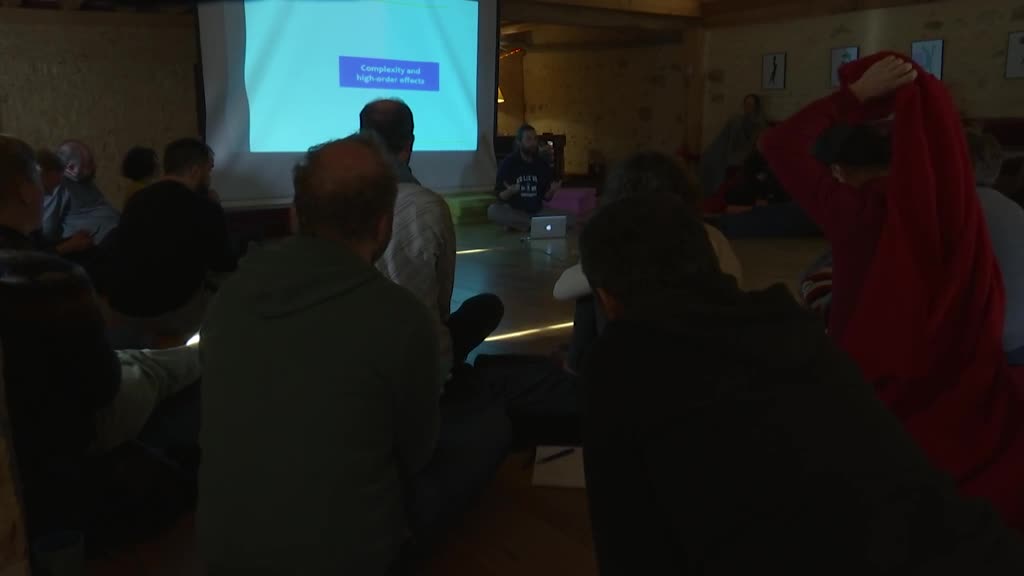Dynamique interactionnelle et multimodalité
Description
Toute interaction est coordonnée, réciproque, dynamique et repose sur des indices ou canaux multimodaux. La recherche du groupe DIM étudie la construction verbale et non verbale du sens pendant l'interaction, ou comment le processus d'interaction lui-même favorise l'émergence du sens.
Cet axe thématique est issu de la convergence entre différents programmes de recherche menés au sein du Labex H2H à l’interface des arts et des sciences (décrits ci-après). Les domaines concernés sont principalement la danse, la poésie en langue des signes, le geste musical… et plus généralement la gestualité et le mouvement en contexte d’interaction artistique. Les membres de SFL impliqués dans ces différents projets ont fait le constat de méthodologies partagées et de besoins en infrastructures expérimentales communes, comme la capture de mouvements par exemple. En échangeant au cours des différents événements scientifiques et artistiques (invitations de chercheurs étrangers, journée d’étude commune, participation aux instances du Labex…), les membres concernés ont également fait le constat de points communs dans l’approche du geste et du mouvement :
- Dynamique : la construction du sens des gestes est conçue comme un processus ; les gestes sont à considérer en séquences et dans leur dynamique et non comme des éléments isolés, ou comme des images avec une dimension figée et exclusivement visuelle.
- Interaction : le sens, le discours est co-construit ; il inclut des ajustements, des phénomènes de (dé)synchronisation entre articulateurs et inter-acteurs.
Cours
Interventions 3ème jour - 1 - Brian Massumi
Interventions 3ème jour - 1 - Brian Massumi
Interventions 2eme matinée - 1 - Fernando Rosas on complexity
Fernando Rosas Interested in the interface between complexity science, communication and information theory, computational neuroscience, collective behaviour, high-order statistics, machine
Interventions 3ème jour - 2 - Anarchive - Erin Manning
Interventions 3ème jour - 2 - Anarchive - Erin Manning
Interventions 3ème jour - 1 - Discussion
Brian Massumi Tommi Himberg Marc R Thompson
Interventions 3ème jour - 1 - Marc R Thompson
Interventions 3ème jour - 1 - Marc R Thompson
Interventions 2eme matinée - 2 - Lior Noy - Leonardo Lancia - Annika Lübbert
Lior Noy Leonardo Lancia Annika Lübbert
Interventions 3ème jour - 1 - Tommi Himberg
Interventions 3ème jour - 1 - Tommi Himberg
Interventions 1ère matinée - 1 - Guy Hoffman - Ella Ben Aharon - Clément Canonne
Guy Hoffman Ella Ben Aharon Clément Canonne
Conférences
Born to share meaning with affection in the rhythm of life
A day with Colwyn Trevarthen and David Lee.
Walking with Parkinson's disease.
Understanding gait disturbances as perceptuomotor coupling between a person and his environement.
Presentation of results of several experiments by Asaf Bachrach
A day with Colwyn Trevarthen and David Lee.
Embodied minds
Interacting minds: combining art and science to explore the social, dynamic, and embodied nature of human cognition In this series of three seminars, we will discuss the view of "extended
Dynamic minds
Interacting minds: combining art and science to explore the social, dynamic, and embodied nature of human cognition In this series of three seminars, we will discuss the view of "extended
Social Minds
Interacting minds: combining art and science to explore the social, dynamic, and embodied nature of human cognition
Carrying the Feeling
Carrying the Feeling explores autistic Lucy Blackman’s use of “carrying” as an expressive force in herwriting. Continuing to delve into what I have called autistic perception theforce of perception
“Quantifying JI” Short talk 1.3: Ashley Walton - Musical Improvisation: Spatiotemporal patterns of …
When jazz musicians perform an improvisational piece of music their behaviors are not fully prescribed in advance. Nonetheless their actions become so tightly coordinated and their decisions so
Operationalizing Social Neuroscience through HumanHuman and HumanMachine Interactions
How are neural, behavioral and social scales coordinated in real time so as to make possible the emergenceof social cognition? Answering this question requires to study the dynamics of coordination in
Documentaire
EyeDance : Le regard en performance
Présentation et retour sur l’installation performative et expérimentale. Dans le cadre du projet Labodance en collaboration avec Mélanie Perrier.
Intervenants
Auteur en médecine
Doctorant du Département de linguistique et de philosophie du MIT, en 2008.
Titulaire d'une thèse d'exercice en Médecine (Lyon 1, 2008)
Médecin rééducateur spécialisé maladie de Parkinson, exerce à Aix-les-bains (2019)
Auteur d'une thèse en Neurosciences à Sorbonne université en 2020
Danseuse et chorégraphe (en 2019)
Psychologue et photographe. Professeur des Universités à l'Université Paris Nanterre (2017)
Comédien, danseur et professeur de Technique Alexander, participe au projet danse et neurosciences du CNRS (2019)


























